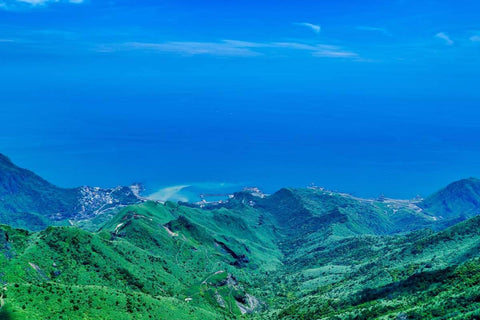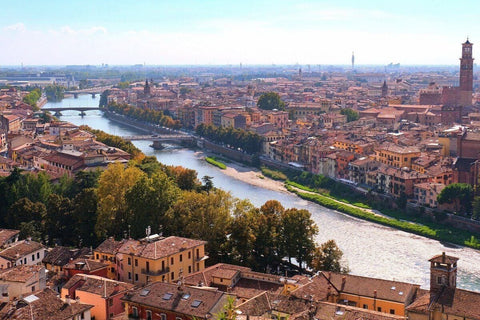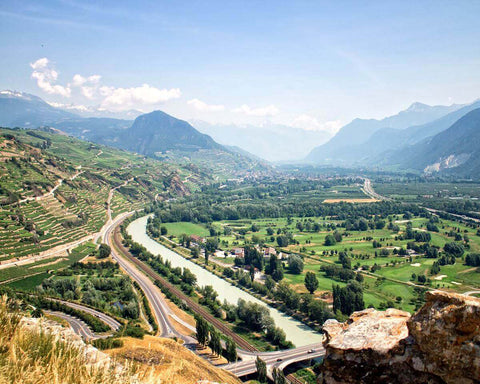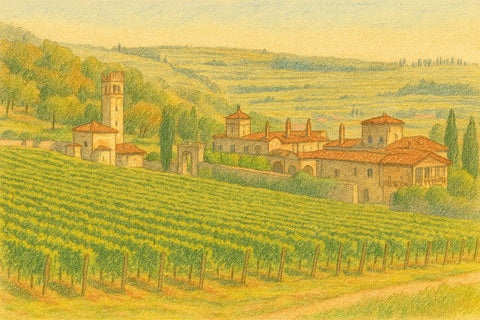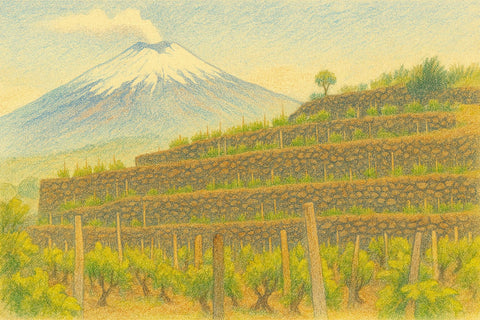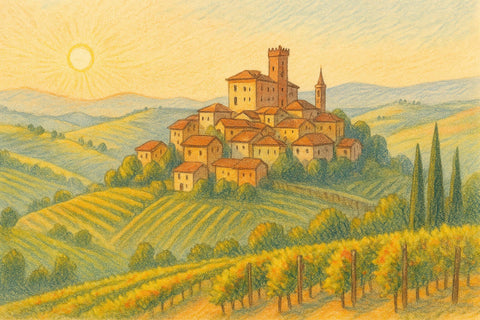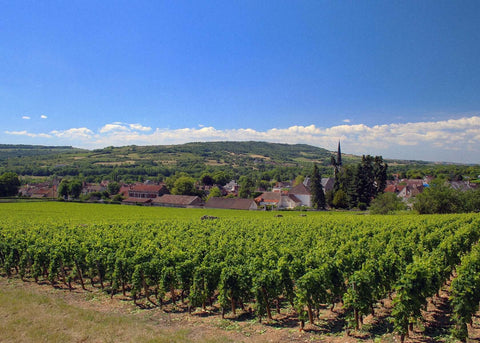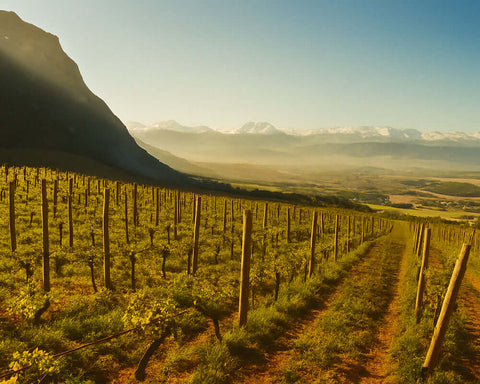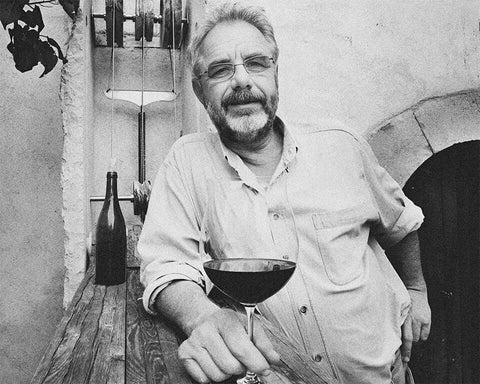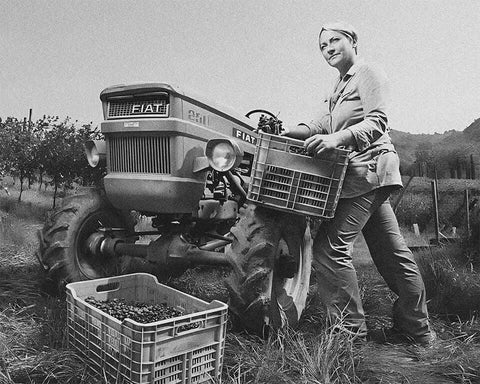Calabria, located at the toe of Italy's boot, is a region of profound historical significance and natural beauty. Encircled by the Tyrrhenian and Ionian Seas, this southern Italian paradise is celebrated globally for its stunning coastline, rugged mountains, and rich cultural heritage.
Over the centuries, Calabria has evolved into a symbol of resilience and tradition, emphasizing preserving its natural landscapes and historical sites. The region's dedication to maintaining its cultural and environmental integrity is a testament to the pride and passion of its people.
Calabria's wines are not just beverages; they express the region's diverse history, commitment to quality, and deep connection to the land. These wines, especially the renowned Cirò and Greco di Bianco, embody the spirit and heritage of Calabria.
Table of Contents
History of Calabria
Calabria, with its strategic position in the Mediterranean, has been a crossroads of cultures and civilizations for millennia. Its history is a rich mosaic of influences, from the ancient Greeks and Romans to the Byzantines and Normans, each leaving an indelible mark on the region.
The Greeks, who established colonies in Calabria during the 8th century BCE, significantly influenced the region's culture and economy. The area known as Magna Graecia became a center of Greek civilization, contributing to Calabria's enduring legacy of art, philosophy, and viticulture.
Roman rule brought further development, with Calabria becoming an important part of the Roman Empire. The Romans enhanced the region's infrastructure, introducing advanced agricultural techniques and expanding viticulture.
Following the fall of the Roman Empire, Calabria experienced a series of invasions and occupations by various powers, including the Byzantines, Lombards, and Normans. Each era contributed to the region's cultural and architectural heritage, visible today in its ancient ruins, churches, and fortresses.
The Normans, who arrived in the 11th century, were particularly influential, establishing a feudal system and fortifying the region. Their legacy includes many of Calabria's iconic castles and religious buildings.
Throughout these historical shifts, one constant remained: Calabria's dedication to preserving its unique identity and traditions. This resilience is reflected in the region's rich culinary heritage, artisanal crafts, and vibrant festivals.
Terroir of Calabria
Calabria's terroir is defined by its diverse landscape, encompassing mountains, hills, and coastal plains. The region enjoys a Mediterranean climate, with hot, dry summers and mild, wet winters, ideal for viticulture and agriculture.
The Apennine Mountains, which run through the heart of Calabria, provide a varied topography that influences the microclimates within the region. The mountainous terrain offers protection from harsh weather and creates a range of growing conditions for different crops.
The soil composition in Calabria varies from the fertile plains along the coast to the rocky, mineral-rich interior soils. This diversity allows for the cultivation of a wide array of grape varieties, each expressing the distinct characteristics of its environment.
The Geology of Calabria
Calabria's landscape is predominantly mountainous, with elevations ranging from sea level to over 2,000 meters in the Aspromonte and Pollino ranges. This rugged terrain contributes to the region's unique geological features, which include a mix of limestone, clay, and volcanic soils.
- Aspromonte: Known for its rugged beauty, the Aspromonte range is characterized by limestone and granite soils, providing a unique terroir for the region's vineyards.
- Sila: This high plateau is rich in clay and volcanic soils, offering excellent drainage and mineral content for viticulture.
- Pollino: The Pollino mountains feature a mix of limestone and sandstone, creating a diverse terroir that supports a variety of grape and olive cultivars.
This geological diversity ensures that each grape variety can thrive in its optimal soil type, enhancing the complexity and expression of Calabria's wines.
Climate and Its Influence
Calabria's climate is predominantly Mediterranean, with hot summers and mild winters. The region benefits from a significant diurnal temperature variation, especially in the mountainous areas, which is crucial for developing grape sugars and acids.
The coastal areas experience more moderate temperatures, influenced by the surrounding seas, while the inland regions see more pronounced seasonal changes. This climatic diversity contributes to the distinctiveness of Calabria's agricultural products, including its wines, olive oils, and citrus fruits.
The Grapes of Calabria
Calabria boasts several indigenous grape varieties, each adapted to the region's unique terroir. The most notable are Gaglioppo, Greco Bianco, and Magliocco.
Red Grape Varietals
- Gaglioppo: The cornerstone of Calabria's most celebrated red wines, such as Cirò. Known for its robust structure and aging potential.
- Magliocco: Produces deeply colored wines with intense fruit flavors and notable tannins.
- Nerello Mascalese: Known for its elegance and ability to reflect the terroir, often compared to Pinot Noir.
- Greco Nero: Adds complexity and spice to red blends.
White Grape Varietals
- Greco Bianco: Known for producing aromatic and complex white wines, especially in the Greco di Bianco DOC.
- Pecorello: Produces fresh and floral wines with good acidity.
- Montonico: An ancient variety making a comeback, known for its versatility and potential for sparkling wines.
- Mantonico: Adds richness and body to white blends.
Top Wines of Calabria
Cirò: Often considered the flagship wine of Calabria, Cirò is made primarily from the Gaglioppo grape. It is known for its deep ruby color, robust structure, and flavors of red fruits and spices. Cirò wines can be enjoyed young or aged for added complexity.
Greco di Bianco: A rare and ancient wine, Greco di Bianco is made from the Greco Bianco grape. It is celebrated for its aromatic intensity and flavors of apricot, honey, and dried fruits. This dessert wine has a long and storied history, reflecting the region's rich viticultural heritage.
Other Notable Wines: Calabria is also home to a variety of other notable wines, including Magliocco-based reds and blends, as well as refreshing white wines from indigenous and international grape varieties. The region's diverse terroir allows for a wide range of wine styles, each offering a unique expression of Calabria's character.
Cuisine and Typical Products of Calabria
Calabria's culinary landscape is as rich and diverse as its history. The region is known for its bold and flavorful dishes, emphasizing local and seasonal ingredients. Calabria's cuisine reflects the influences of its varied past, from Greek and Roman to Arab and Norman, creating a unique and vibrant culinary tradition.
chili peppers, known locally as 'peperoncino,' is a hallmark of Calabrian cuisine, adding heat and depth to many dishes. Other staples include eggplant, tomatoes, olives, and a variety of seafood, reflecting the region's agricultural abundance and coastal access.
Calabria is also famous for its cured meats and cheeses, integral to the local diet and culinary identity. From spicy 'nduja sausage to the creamy and tangy Caciocavallo cheese, these products showcase the region's dedication to artisanal food production.
Calabrian Antipasti
In Calabria, a meal often begins with a selection of antipasti featuring local cheeses, cured meats, and marinated vegetables. These appetizers set the stage for the hearty courses to follow.
- 'Nduja: A spicy, spreadable sausage made from pork and chili peppers, often served on bread or mixed into pasta dishes.
- Pepperoni ripieni: Stuffed peppers filled with breadcrumbs, anchovies, and capers, a flavorful and savory starter.
- Melanzane sott'olio: Marinated eggplant preserved in olive oil, garlic, and herbs, a classic Calab rian antipasto.
- Frittata di cipolle: A simple onion frittata, highlighting the sweetness of Calabrian onions.
Calabrian Primi Piatti (First Courses)
The first course in a Calabrian meal often features pasta, risotto, or hearty soups. These dishes showcase the region's grains, legumes, and seasonal vegetables.
- Fileja: A traditional pasta shape often served with a rich tomato sauce and 'nduja or pork ragù.
- Lagane e ceci: A rustic pasta and chickpea soup seasoned with garlic, rosemary, and olive oil.
- Pasta alla 'nduja: Pasta served with a spicy sauce made from 'nduja, tomatoes, and olive oil, a quintessential Calabrian dish.
- Risotto alla liquirizia: A unique risotto flavored with Calabrian licorice, reflecting the region's innovative culinary spirit.
Calabrian Secondi (Second Courses)
Calabria is known for its high-quality meats, particularly pork and goat. The second course often features these prized ingredients, prepared with local herbs and spices.
- Capretto al forno: Oven-roasted kid goat, seasoned with rosemary, garlic, and olive oil.
- Salsiccia Calabrese: Spicy Calabrian sausage, often grilled or used in stews.
- Pesce spada alla ghiotta: Swordfish cooked with tomatoes, olives, and capers, showcasing the region's seafood heritage.
- Cozze gratinate: Baked mussels topped with breadcrumbs, garlic, and parsley, a delicious coastal dish.
Calabrian Contorni (Side Dishes)
Calabrian cuisine features an array of vegetable side dishes, highlighting the region's agricultural bounty.
- Pipi e patate: Fried peppers and potatoes, a simple yet flavorful accompaniment to many meals.
- Zucchine alla scapece: Marinated zucchini with mint and vinegar, a refreshing side dish.
- Insalata di arance: Orange salad with fennel and olives, a vibrant and citrusy dish.
Calabrian Formaggi (Cheeses)
Calabria produces some of Italy's most distinctive cheeses, often enjoyed as part of a cheese course or used in cooking.
- Caciocavallo: A semi-hard cheese with a tangy flavor, often aged and enjoyed with bread and honey.
- Pecorino Crotonese: A sheep's milk cheese with a robust flavor, perfect for grating over pasta.
- Ricotta Affumicata: Smoked ricotta, used in both savory dishes and desserts.
- Butirro: A unique cheese with a butter core, traditionally made in small round shapes.
Calabrian Dolci (Desserts)
Calabrian desserts often feature local ingredients such as almonds, citrus fruits, and honey.
- Pignolata: A festive dessert made of fried dough balls coated in honey or chocolate.
- Torrone di Bagnara: A nougat made with almonds, honey, and citrus zest, a traditional holiday treat.
- Tartufo di Pizzo: A famous gelato dessert with a rich chocolate and hazelnut filling.
- Cuzzupa: A traditional Easter cake, often shaped into symbolic forms and decorated with colorful eggs.
Typical Products of Calabria
Calabria's cuisine is based on high-quality local products, many of which have achieved protected status, ensuring authenticity and traditional production methods.
Chili Peppers
The Calabrian chili pepper, or 'peperoncino,' is a key ingredient in many local dishes. Known for its heat and flavor, it is used fresh, dried, or preserved in oil.
Olive Oil
Calabria is one of Italy's major olive oil producers, with several varieties of olives cultivated across the region. The oil is known for its rich, fruity flavor and is a staple in Calabrian cooking.
Cheese
Calabria produces a wide variety of cheeses, each reflecting the characteristics of its production area.
- Provola Silana: A semi-hard cheese from the Sila plateau, known for its mild flavor and smooth texture.
- Pecorino del Monte Poro: A robust sheep's milk cheese from the Monte Poro area, aged to develop a rich and intense flavor.
- Caprino della Limina: A goat's milk cheese from the Aspromonte region, noted for its creamy texture and tangy taste.
Meat and Charcuterie
Calabrian meat products are known for their quality and distinctive flavors.
- 'Nduja: A spicy, spreadable sausage made from pork and chili peppers, often used in pasta sauces and as a pizza topping.
- Soppressata di Calabria DOP: A dry-cured salami made from pork, seasoned with chili peppers and other spices.
- Capocollo di Calabria DOP: A cured pork shoulder seasoned with black pepper and sometimes chili, known for its rich flavor and tender texture.
Fruits and Vegetables
Calabria's varied climate allows cultivating a wide range of produce.
- Bergamot: A citrus fruit grown primarily in the province of Reggio Calabria, known for its fragrant oil used in perfumes and as a flavoring in food and beverages.
- Cedro: Another citrus fruit, the citron, is used in traditional desserts and liqueurs.
- Tropea Onions: Sweet red onions from the town of Tropea are celebrated for their mild flavor and versatility in cooking.
